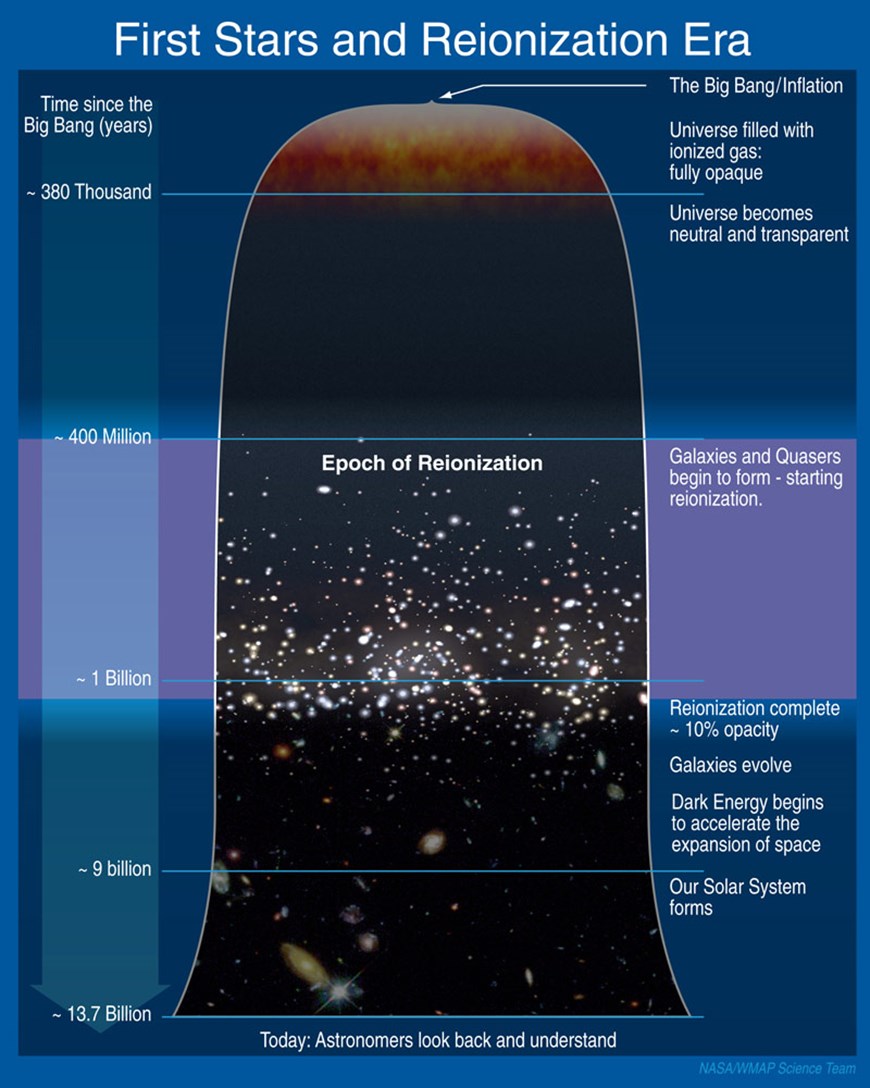Evolution of the Universe: Year 11
This activity gives students a sense of how the Universe evolved since the beginning of time.
What to do
Watch one or more of the following videos of these talented professors explaining how the Universe evolved to gain the information you will need for the following activities.
Prof Max Tegmark
Prof Brian Cox
Prof Brian Schmidt
- Study the image depicting the various stages of the evolution of the Universe. This image was taken from the NASA website. You may need to research the different stages of the Universe in more detail to help you with the next task. The stages of evolution can be divided into six parts:

Approximate time-line of the evolution of the Universe from the Big Bang to the present.
Source: NASA
Photo: WMAP Science Team - The first three minutes after the Big Bang
- The Early Universe (between three minutes and 380,000 years after the Big Bang)
- The Dark Ages (between 380,000 years and 400 million years after the Big Bang)
- Era of Ionisation (between 400 million years and 1 billion years after the Big Bang)
- Era of galaxy abundance (between 1 billion and 9 billion years after the Big Bang)
- The local Universe (between 9 billion and 13.7 billion years after the Big Bang.)
- In your groups of two or three, represent each stage with any object that you can fit inside a standard archive box (approximately 415 L x 315 W x 265 H mm). You and your team members will need to be very creative and be able to rationalise why you chose each object to represent each stage.
- Collect the objects identified in Question 2 and create a 3–4 minute video that uses these objects to explain the evolution of the Universe from the time of the Big Bang to the present time.
- Use free Apps or websites that allow you to develop your own digital timeline. Include images, photographs, text and animations that you have researched on the internet. Examples can be found on the e-Learing Industry website.
Note: Year 11 VCE Physics student’s extension:
Include the relationship between space and time, expansion and cooling, inflation, elementary particle formation, annihilation, antimatter and matter, commencement of nuclear fusion, cessation of fusion and the formation of atoms in your digital timeline.
Extension research questions
- Choose a stage in the evolution of the Universe.
- What significant technology or telescope was necessary for the discoveries made in this part of the evolution of the universe?
- Who were some of the people that made these important discoveries possible?
- What are some of the social consequences of these discoveries?
- What career opportunities do you think were created as a result of these discoveries?
Advice to teachers
This activity is aimed at Year 10 Science/Astronomy students and VCE Year 11 Physics students. It links to the Victorian Curriculum for:
- Year 10 Science: Earth and Space Sciences, Science as a Human Endeavour
- Capabilities: Creative and Critical, Personal, and Social and Ethical.
- Year 11 VCE Physics – Area of Study: What is matter and how is it formed?
The skills that will be used and challenged in these tasks include: research, critical thinking, creative thinking, problem solving, communication and negotiation skills.